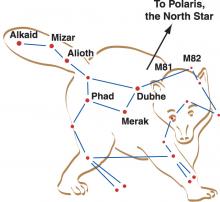If you ever look heavenward, you know that people have found pictures in the stars for thousands of years. I think most of us can recognize a few, like Orion t he
he  Hunter, with his three-star belt, and the Big Dipper (actually part of Ursa Major, the Great Bear).
Hunter, with his three-star belt, and the Big Dipper (actually part of Ursa Major, the Great Bear).
But I hadn’t realized how many constellations have gone “extinct.” Prior to 1928, when the International Astronomical Union officially recognized 88 constellations, naming and promoting star patterns was a pretty haphazard event.
For example, there was the Battery of Volta, designated by British physician and Egyptology Thomas Young in 1806 to honor the invention of the electric battery by Alessandro Volta. But since it was just two stars (battery terminals?), this one never caught on.
In 1684, German astronomer Gottfried Kirch introduced Gladii Electorales Saxonici, a star pattern resembling two crossed swords, to try in win the patronage of Johann Georg III, Elector of Saxony (it must not have worked; picture from Goggle Images).
In the skies over the Southern Hemisphere, in 1810 American mapmaker William Croswell placed a pattern he called Marmor Sculptile on A Mercator Map of the Starry Heavens that represented a bust of Christopher Columbus. Actually he used the existing constellation Reticulum plus a few neighboring stars, so it wasn’t terribly original.
There are many others. If you enjoy astronomy, researching extinct constellations could provide a novel twist to your hobby.
Taken from “Spectors of Past Constellations” by Michael E. Bakich in the February 2019 issue of Astronomy magazine (and unfortunately is not on the Internet). The pictures came from Stardate’s Constellation Guide https://stardate.org/nightsky/constellations.
